Applied Research Project: Tesco's Response to Business Changes
VerifiedAdded on 2023/06/09
|31
|10091
|144
Project
AI Summary
This applied research project investigates Tesco's strategies for responding to and managing changes in the business environment. The study, based on qualitative analysis of survey data from 30 Tesco managers, explores factors influencing organizational change and the company's adaptation. The research examines change management processes, prioritizing organizational changes, and the role of management in navigating a dynamic market. The project includes a literature review, detailed methodology, data analysis with thematic evaluation, and conclusions with recommendations for improvement. The findings suggest that Tesco has effectively managed the changing business environment, highlighting key strategies and approaches to maintain its position in the competitive retail sector. The report provides a comprehensive overview of Tesco's responses to market dynamics, with insights into change management practices and their impact on the organization.
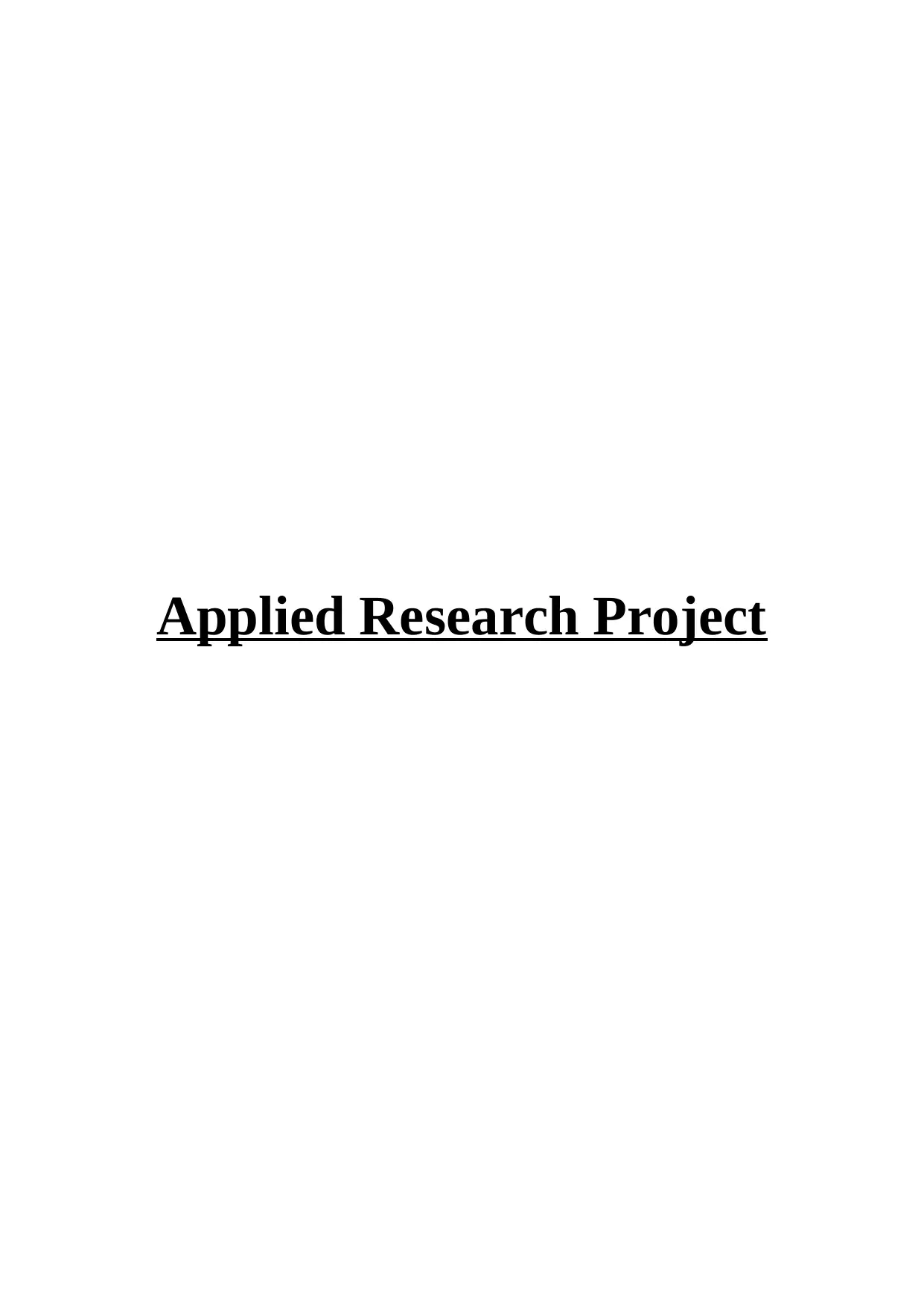
Applied Research Project
Paraphrase This Document
Need a fresh take? Get an instant paraphrase of this document with our AI Paraphraser
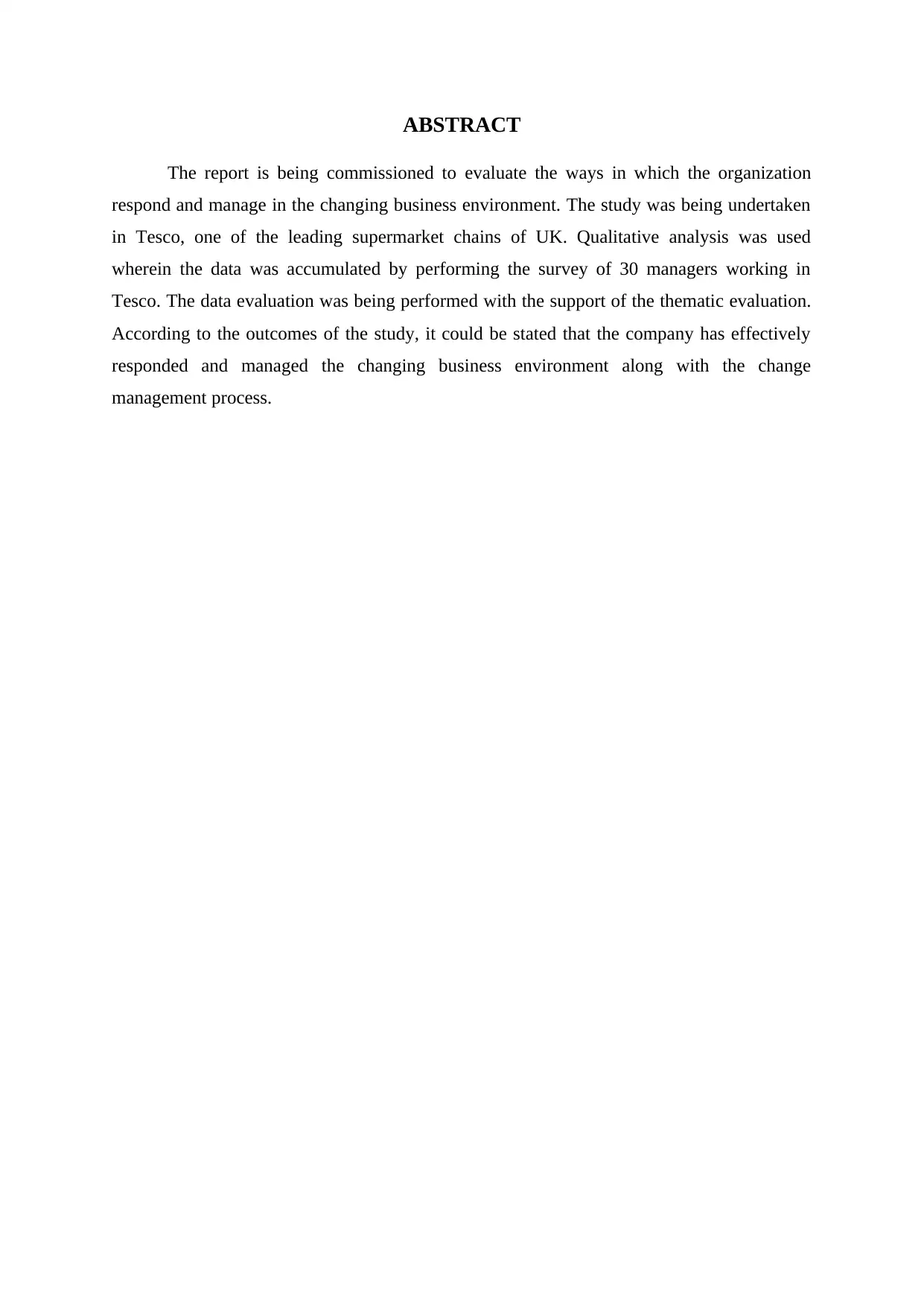
ABSTRACT
The report is being commissioned to evaluate the ways in which the organization
respond and manage in the changing business environment. The study was being undertaken
in Tesco, one of the leading supermarket chains of UK. Qualitative analysis was used
wherein the data was accumulated by performing the survey of 30 managers working in
Tesco. The data evaluation was being performed with the support of the thematic evaluation.
According to the outcomes of the study, it could be stated that the company has effectively
responded and managed the changing business environment along with the change
management process.
The report is being commissioned to evaluate the ways in which the organization
respond and manage in the changing business environment. The study was being undertaken
in Tesco, one of the leading supermarket chains of UK. Qualitative analysis was used
wherein the data was accumulated by performing the survey of 30 managers working in
Tesco. The data evaluation was being performed with the support of the thematic evaluation.
According to the outcomes of the study, it could be stated that the company has effectively
responded and managed the changing business environment along with the change
management process.
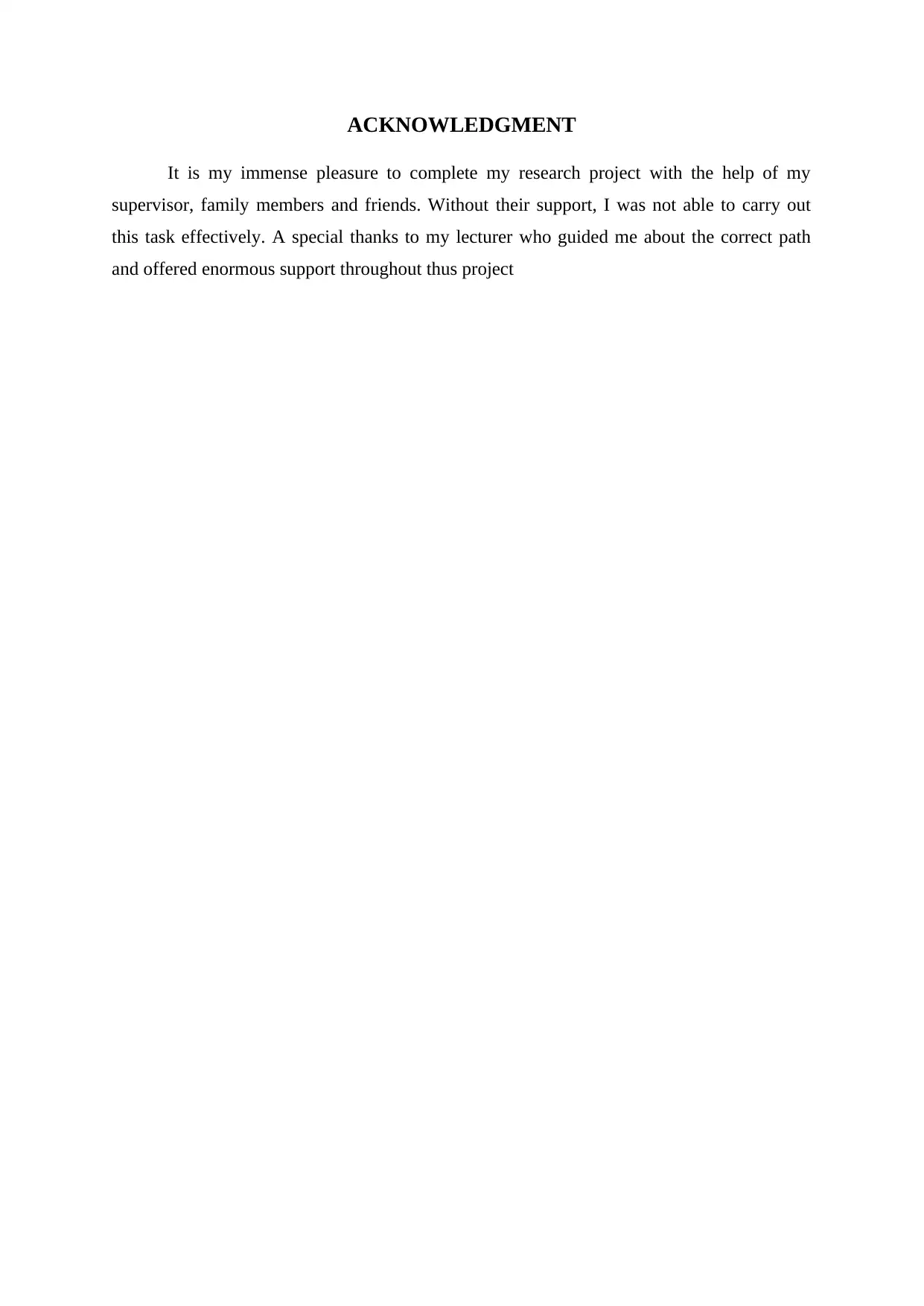
ACKNOWLEDGMENT
It is my immense pleasure to complete my research project with the help of my
supervisor, family members and friends. Without their support, I was not able to carry out
this task effectively. A special thanks to my lecturer who guided me about the correct path
and offered enormous support throughout thus project
It is my immense pleasure to complete my research project with the help of my
supervisor, family members and friends. Without their support, I was not able to carry out
this task effectively. A special thanks to my lecturer who guided me about the correct path
and offered enormous support throughout thus project
⊘ This is a preview!⊘
Do you want full access?
Subscribe today to unlock all pages.

Trusted by 1+ million students worldwide
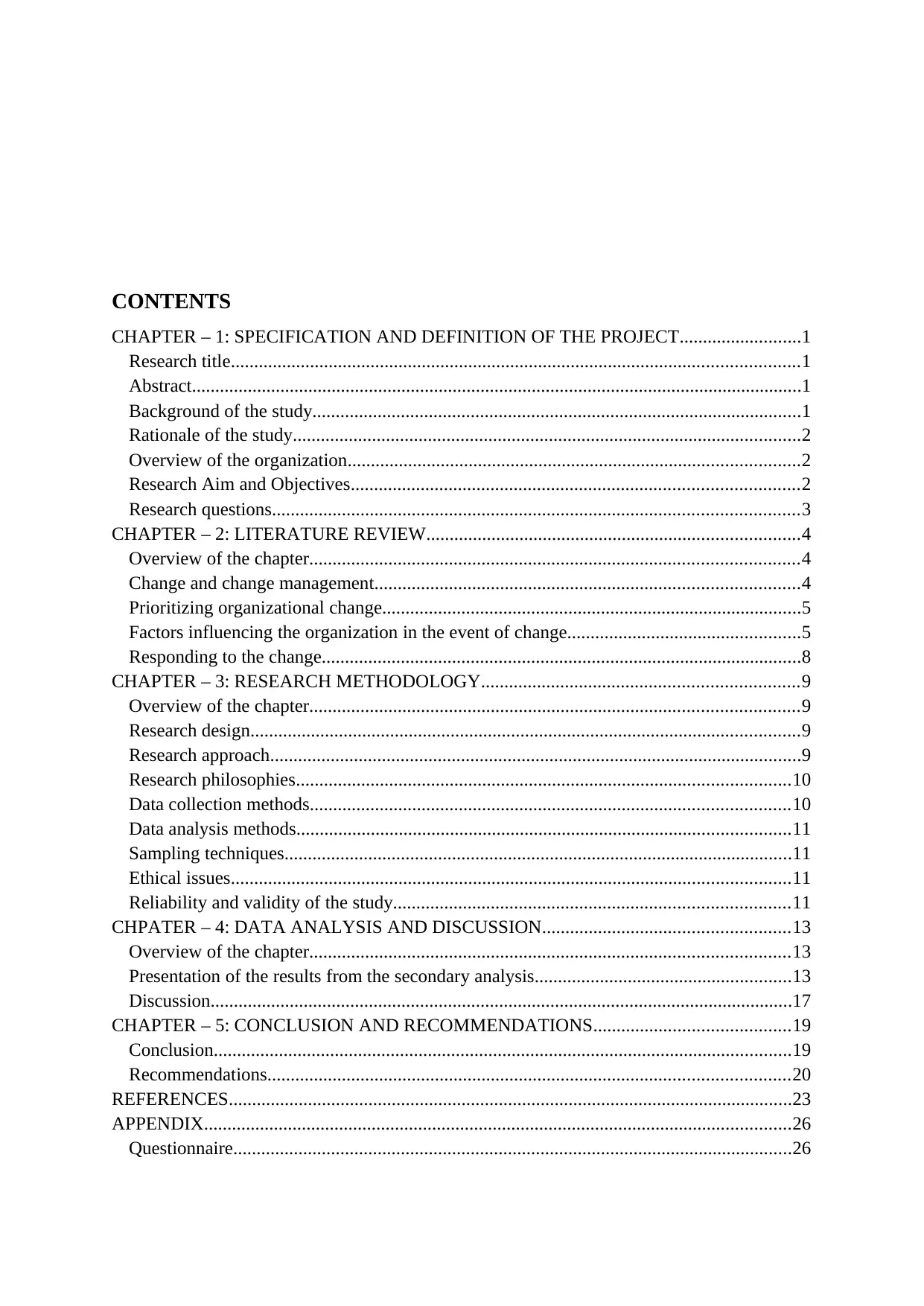
CONTENTS
CHAPTER – 1: SPECIFICATION AND DEFINITION OF THE PROJECT..........................1
Research title..........................................................................................................................1
Abstract...................................................................................................................................1
Background of the study.........................................................................................................1
Rationale of the study.............................................................................................................2
Overview of the organization.................................................................................................2
Research Aim and Objectives................................................................................................2
Research questions.................................................................................................................3
CHAPTER – 2: LITERATURE REVIEW................................................................................4
Overview of the chapter.........................................................................................................4
Change and change management...........................................................................................4
Prioritizing organizational change..........................................................................................5
Factors influencing the organization in the event of change..................................................5
Responding to the change.......................................................................................................8
CHAPTER – 3: RESEARCH METHODOLOGY....................................................................9
Overview of the chapter.........................................................................................................9
Research design......................................................................................................................9
Research approach..................................................................................................................9
Research philosophies..........................................................................................................10
Data collection methods.......................................................................................................10
Data analysis methods..........................................................................................................11
Sampling techniques.............................................................................................................11
Ethical issues........................................................................................................................11
Reliability and validity of the study.....................................................................................11
CHPATER – 4: DATA ANALYSIS AND DISCUSSION.....................................................13
Overview of the chapter.......................................................................................................13
Presentation of the results from the secondary analysis.......................................................13
Discussion.............................................................................................................................17
CHAPTER – 5: CONCLUSION AND RECOMMENDATIONS..........................................19
Conclusion............................................................................................................................19
Recommendations................................................................................................................20
REFERENCES.........................................................................................................................23
APPENDIX..............................................................................................................................26
Questionnaire........................................................................................................................26
CHAPTER – 1: SPECIFICATION AND DEFINITION OF THE PROJECT..........................1
Research title..........................................................................................................................1
Abstract...................................................................................................................................1
Background of the study.........................................................................................................1
Rationale of the study.............................................................................................................2
Overview of the organization.................................................................................................2
Research Aim and Objectives................................................................................................2
Research questions.................................................................................................................3
CHAPTER – 2: LITERATURE REVIEW................................................................................4
Overview of the chapter.........................................................................................................4
Change and change management...........................................................................................4
Prioritizing organizational change..........................................................................................5
Factors influencing the organization in the event of change..................................................5
Responding to the change.......................................................................................................8
CHAPTER – 3: RESEARCH METHODOLOGY....................................................................9
Overview of the chapter.........................................................................................................9
Research design......................................................................................................................9
Research approach..................................................................................................................9
Research philosophies..........................................................................................................10
Data collection methods.......................................................................................................10
Data analysis methods..........................................................................................................11
Sampling techniques.............................................................................................................11
Ethical issues........................................................................................................................11
Reliability and validity of the study.....................................................................................11
CHPATER – 4: DATA ANALYSIS AND DISCUSSION.....................................................13
Overview of the chapter.......................................................................................................13
Presentation of the results from the secondary analysis.......................................................13
Discussion.............................................................................................................................17
CHAPTER – 5: CONCLUSION AND RECOMMENDATIONS..........................................19
Conclusion............................................................................................................................19
Recommendations................................................................................................................20
REFERENCES.........................................................................................................................23
APPENDIX..............................................................................................................................26
Questionnaire........................................................................................................................26
Paraphrase This Document
Need a fresh take? Get an instant paraphrase of this document with our AI Paraphraser
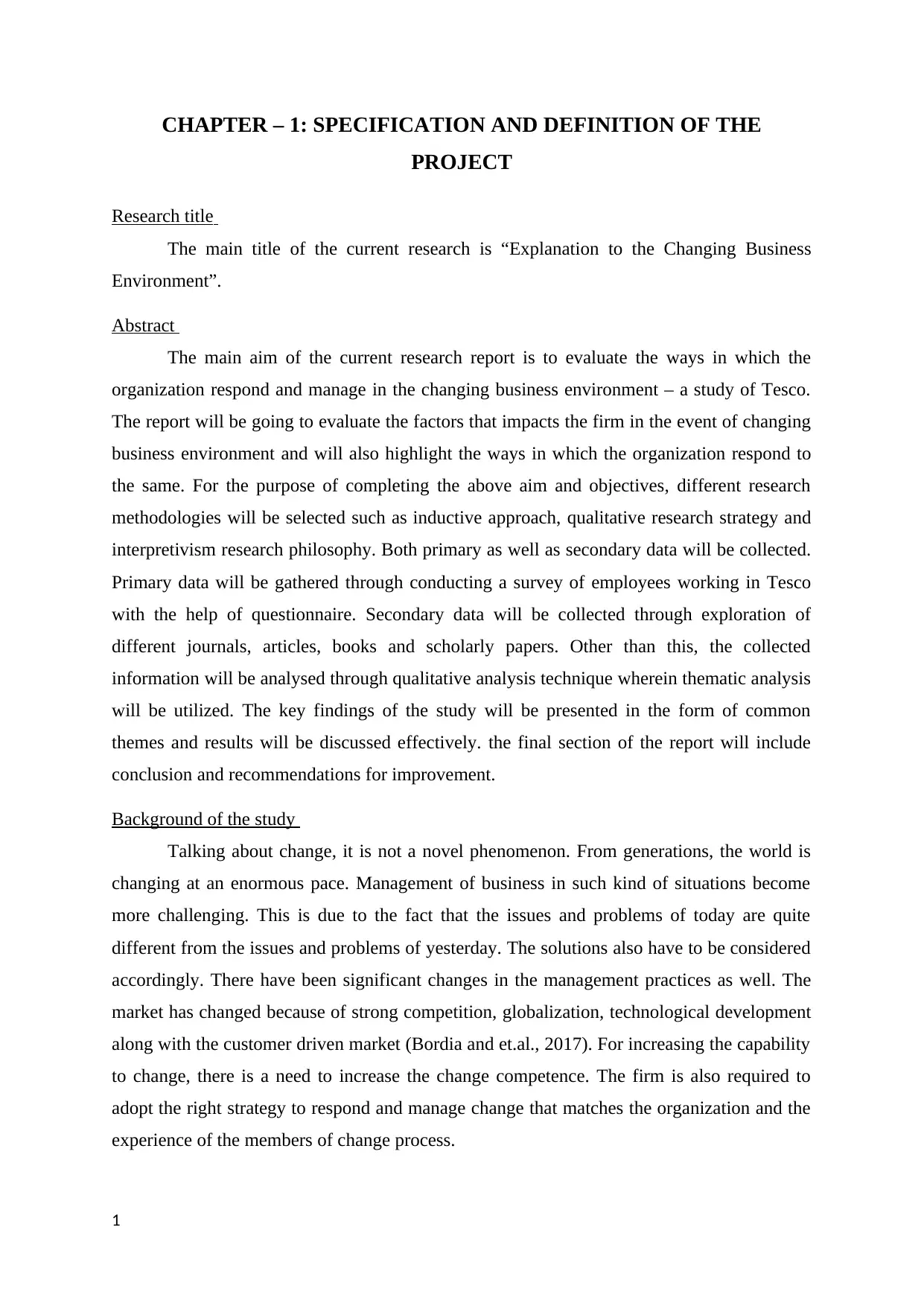
CHAPTER – 1: SPECIFICATION AND DEFINITION OF THE
PROJECT
Research title
The main title of the current research is “Explanation to the Changing Business
Environment”.
Abstract
The main aim of the current research report is to evaluate the ways in which the
organization respond and manage in the changing business environment – a study of Tesco.
The report will be going to evaluate the factors that impacts the firm in the event of changing
business environment and will also highlight the ways in which the organization respond to
the same. For the purpose of completing the above aim and objectives, different research
methodologies will be selected such as inductive approach, qualitative research strategy and
interpretivism research philosophy. Both primary as well as secondary data will be collected.
Primary data will be gathered through conducting a survey of employees working in Tesco
with the help of questionnaire. Secondary data will be collected through exploration of
different journals, articles, books and scholarly papers. Other than this, the collected
information will be analysed through qualitative analysis technique wherein thematic analysis
will be utilized. The key findings of the study will be presented in the form of common
themes and results will be discussed effectively. the final section of the report will include
conclusion and recommendations for improvement.
Background of the study
Talking about change, it is not a novel phenomenon. From generations, the world is
changing at an enormous pace. Management of business in such kind of situations become
more challenging. This is due to the fact that the issues and problems of today are quite
different from the issues and problems of yesterday. The solutions also have to be considered
accordingly. There have been significant changes in the management practices as well. The
market has changed because of strong competition, globalization, technological development
along with the customer driven market (Bordia and et.al., 2017). For increasing the capability
to change, there is a need to increase the change competence. The firm is also required to
adopt the right strategy to respond and manage change that matches the organization and the
experience of the members of change process.
1
PROJECT
Research title
The main title of the current research is “Explanation to the Changing Business
Environment”.
Abstract
The main aim of the current research report is to evaluate the ways in which the
organization respond and manage in the changing business environment – a study of Tesco.
The report will be going to evaluate the factors that impacts the firm in the event of changing
business environment and will also highlight the ways in which the organization respond to
the same. For the purpose of completing the above aim and objectives, different research
methodologies will be selected such as inductive approach, qualitative research strategy and
interpretivism research philosophy. Both primary as well as secondary data will be collected.
Primary data will be gathered through conducting a survey of employees working in Tesco
with the help of questionnaire. Secondary data will be collected through exploration of
different journals, articles, books and scholarly papers. Other than this, the collected
information will be analysed through qualitative analysis technique wherein thematic analysis
will be utilized. The key findings of the study will be presented in the form of common
themes and results will be discussed effectively. the final section of the report will include
conclusion and recommendations for improvement.
Background of the study
Talking about change, it is not a novel phenomenon. From generations, the world is
changing at an enormous pace. Management of business in such kind of situations become
more challenging. This is due to the fact that the issues and problems of today are quite
different from the issues and problems of yesterday. The solutions also have to be considered
accordingly. There have been significant changes in the management practices as well. The
market has changed because of strong competition, globalization, technological development
along with the customer driven market (Bordia and et.al., 2017). For increasing the capability
to change, there is a need to increase the change competence. The firm is also required to
adopt the right strategy to respond and manage change that matches the organization and the
experience of the members of change process.
1
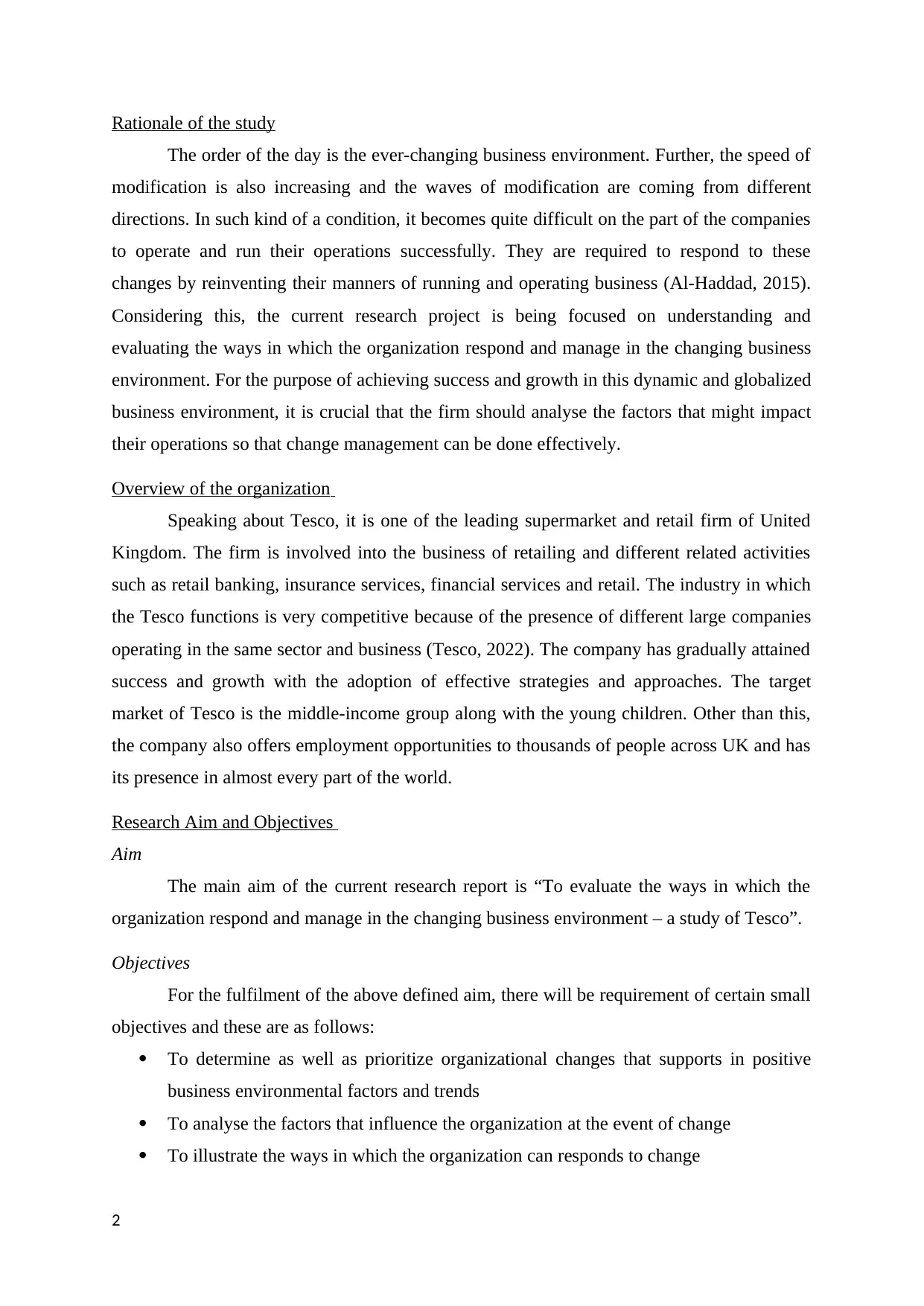
Rationale of the study
The order of the day is the ever-changing business environment. Further, the speed of
modification is also increasing and the waves of modification are coming from different
directions. In such kind of a condition, it becomes quite difficult on the part of the companies
to operate and run their operations successfully. They are required to respond to these
changes by reinventing their manners of running and operating business (Al-Haddad, 2015).
Considering this, the current research project is being focused on understanding and
evaluating the ways in which the organization respond and manage in the changing business
environment. For the purpose of achieving success and growth in this dynamic and globalized
business environment, it is crucial that the firm should analyse the factors that might impact
their operations so that change management can be done effectively.
Overview of the organization
Speaking about Tesco, it is one of the leading supermarket and retail firm of United
Kingdom. The firm is involved into the business of retailing and different related activities
such as retail banking, insurance services, financial services and retail. The industry in which
the Tesco functions is very competitive because of the presence of different large companies
operating in the same sector and business (Tesco, 2022). The company has gradually attained
success and growth with the adoption of effective strategies and approaches. The target
market of Tesco is the middle-income group along with the young children. Other than this,
the company also offers employment opportunities to thousands of people across UK and has
its presence in almost every part of the world.
Research Aim and Objectives
Aim
The main aim of the current research report is “To evaluate the ways in which the
organization respond and manage in the changing business environment – a study of Tesco”.
Objectives
For the fulfilment of the above defined aim, there will be requirement of certain small
objectives and these are as follows:
To determine as well as prioritize organizational changes that supports in positive
business environmental factors and trends
To analyse the factors that influence the organization at the event of change
To illustrate the ways in which the organization can responds to change
2
The order of the day is the ever-changing business environment. Further, the speed of
modification is also increasing and the waves of modification are coming from different
directions. In such kind of a condition, it becomes quite difficult on the part of the companies
to operate and run their operations successfully. They are required to respond to these
changes by reinventing their manners of running and operating business (Al-Haddad, 2015).
Considering this, the current research project is being focused on understanding and
evaluating the ways in which the organization respond and manage in the changing business
environment. For the purpose of achieving success and growth in this dynamic and globalized
business environment, it is crucial that the firm should analyse the factors that might impact
their operations so that change management can be done effectively.
Overview of the organization
Speaking about Tesco, it is one of the leading supermarket and retail firm of United
Kingdom. The firm is involved into the business of retailing and different related activities
such as retail banking, insurance services, financial services and retail. The industry in which
the Tesco functions is very competitive because of the presence of different large companies
operating in the same sector and business (Tesco, 2022). The company has gradually attained
success and growth with the adoption of effective strategies and approaches. The target
market of Tesco is the middle-income group along with the young children. Other than this,
the company also offers employment opportunities to thousands of people across UK and has
its presence in almost every part of the world.
Research Aim and Objectives
Aim
The main aim of the current research report is “To evaluate the ways in which the
organization respond and manage in the changing business environment – a study of Tesco”.
Objectives
For the fulfilment of the above defined aim, there will be requirement of certain small
objectives and these are as follows:
To determine as well as prioritize organizational changes that supports in positive
business environmental factors and trends
To analyse the factors that influence the organization at the event of change
To illustrate the ways in which the organization can responds to change
2
⊘ This is a preview!⊘
Do you want full access?
Subscribe today to unlock all pages.

Trusted by 1+ million students worldwide
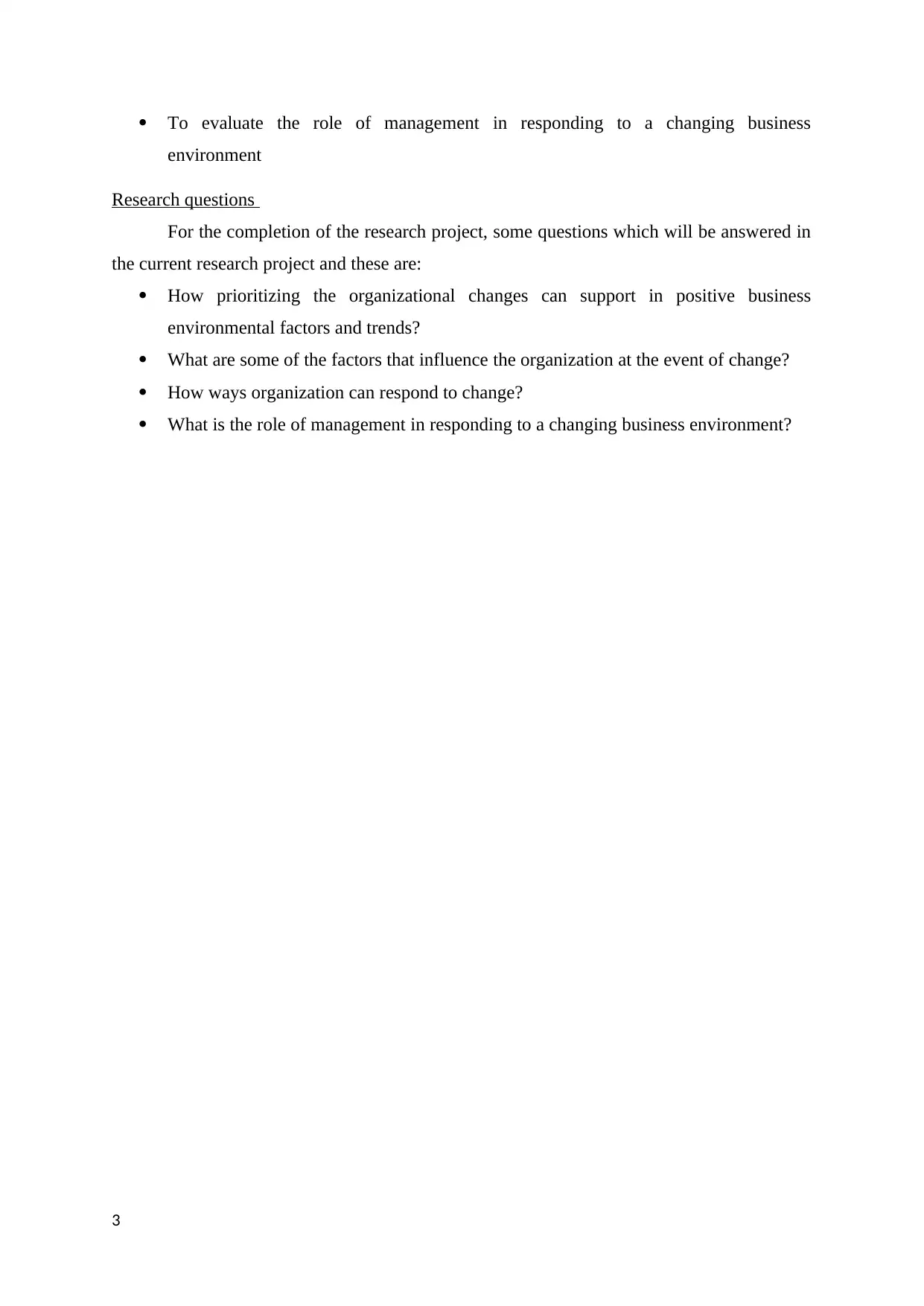
To evaluate the role of management in responding to a changing business
environment
Research questions
For the completion of the research project, some questions which will be answered in
the current research project and these are:
How prioritizing the organizational changes can support in positive business
environmental factors and trends?
What are some of the factors that influence the organization at the event of change?
How ways organization can respond to change?
What is the role of management in responding to a changing business environment?
3
environment
Research questions
For the completion of the research project, some questions which will be answered in
the current research project and these are:
How prioritizing the organizational changes can support in positive business
environmental factors and trends?
What are some of the factors that influence the organization at the event of change?
How ways organization can respond to change?
What is the role of management in responding to a changing business environment?
3
Paraphrase This Document
Need a fresh take? Get an instant paraphrase of this document with our AI Paraphraser
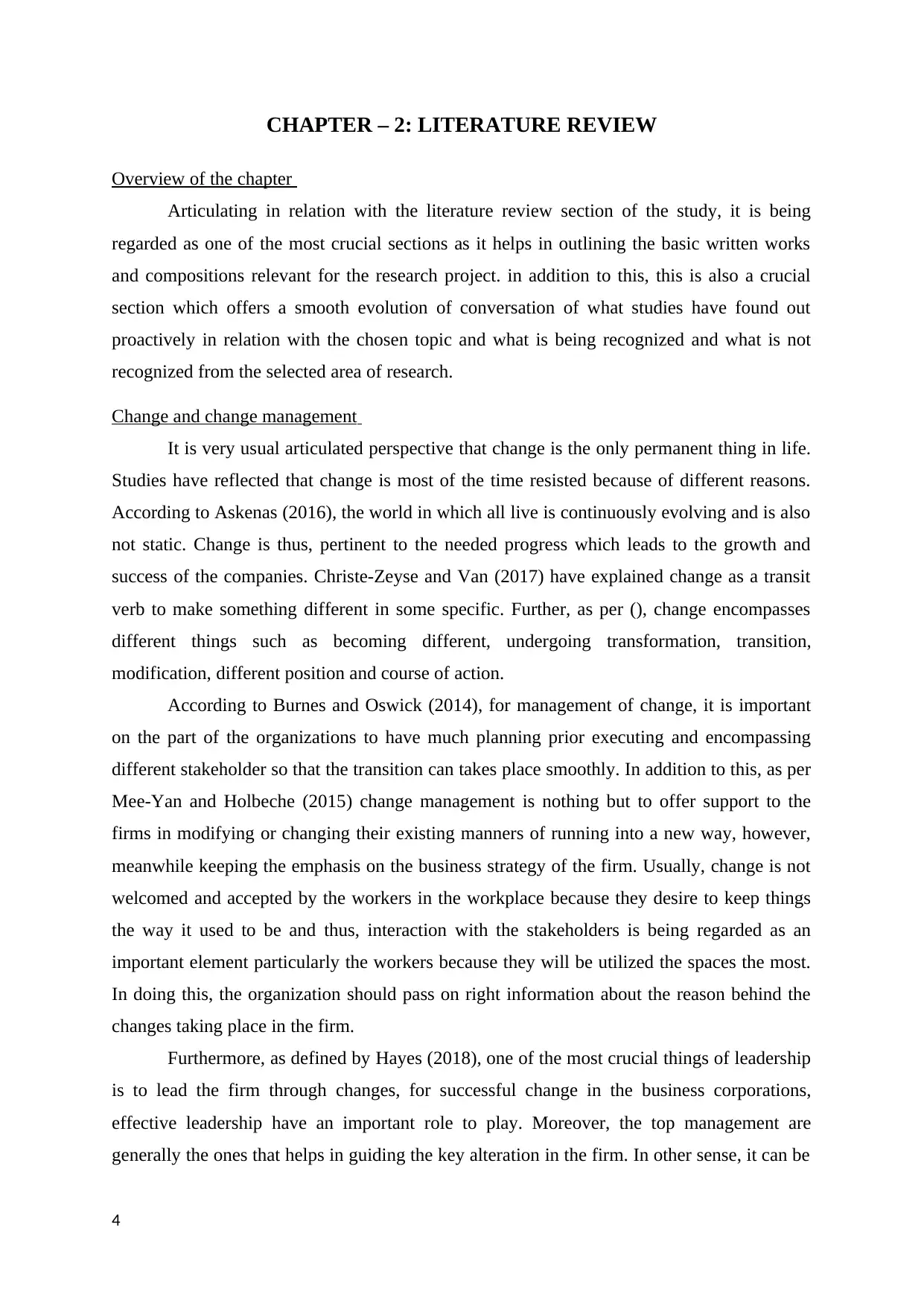
CHAPTER – 2: LITERATURE REVIEW
Overview of the chapter
Articulating in relation with the literature review section of the study, it is being
regarded as one of the most crucial sections as it helps in outlining the basic written works
and compositions relevant for the research project. in addition to this, this is also a crucial
section which offers a smooth evolution of conversation of what studies have found out
proactively in relation with the chosen topic and what is being recognized and what is not
recognized from the selected area of research.
Change and change management
It is very usual articulated perspective that change is the only permanent thing in life.
Studies have reflected that change is most of the time resisted because of different reasons.
According to Askenas (2016), the world in which all live is continuously evolving and is also
not static. Change is thus, pertinent to the needed progress which leads to the growth and
success of the companies. Christe‐Zeyse and Van (2017) have explained change as a transit
verb to make something different in some specific. Further, as per (), change encompasses
different things such as becoming different, undergoing transformation, transition,
modification, different position and course of action.
According to Burnes and Oswick (2014), for management of change, it is important
on the part of the organizations to have much planning prior executing and encompassing
different stakeholder so that the transition can takes place smoothly. In addition to this, as per
Mee-Yan and Holbeche (2015) change management is nothing but to offer support to the
firms in modifying or changing their existing manners of running into a new way, however,
meanwhile keeping the emphasis on the business strategy of the firm. Usually, change is not
welcomed and accepted by the workers in the workplace because they desire to keep things
the way it used to be and thus, interaction with the stakeholders is being regarded as an
important element particularly the workers because they will be utilized the spaces the most.
In doing this, the organization should pass on right information about the reason behind the
changes taking place in the firm.
Furthermore, as defined by Hayes (2018), one of the most crucial things of leadership
is to lead the firm through changes, for successful change in the business corporations,
effective leadership have an important role to play. Moreover, the top management are
generally the ones that helps in guiding the key alteration in the firm. In other sense, it can be
4
Overview of the chapter
Articulating in relation with the literature review section of the study, it is being
regarded as one of the most crucial sections as it helps in outlining the basic written works
and compositions relevant for the research project. in addition to this, this is also a crucial
section which offers a smooth evolution of conversation of what studies have found out
proactively in relation with the chosen topic and what is being recognized and what is not
recognized from the selected area of research.
Change and change management
It is very usual articulated perspective that change is the only permanent thing in life.
Studies have reflected that change is most of the time resisted because of different reasons.
According to Askenas (2016), the world in which all live is continuously evolving and is also
not static. Change is thus, pertinent to the needed progress which leads to the growth and
success of the companies. Christe‐Zeyse and Van (2017) have explained change as a transit
verb to make something different in some specific. Further, as per (), change encompasses
different things such as becoming different, undergoing transformation, transition,
modification, different position and course of action.
According to Burnes and Oswick (2014), for management of change, it is important
on the part of the organizations to have much planning prior executing and encompassing
different stakeholder so that the transition can takes place smoothly. In addition to this, as per
Mee-Yan and Holbeche (2015) change management is nothing but to offer support to the
firms in modifying or changing their existing manners of running into a new way, however,
meanwhile keeping the emphasis on the business strategy of the firm. Usually, change is not
welcomed and accepted by the workers in the workplace because they desire to keep things
the way it used to be and thus, interaction with the stakeholders is being regarded as an
important element particularly the workers because they will be utilized the spaces the most.
In doing this, the organization should pass on right information about the reason behind the
changes taking place in the firm.
Furthermore, as defined by Hayes (2018), one of the most crucial things of leadership
is to lead the firm through changes, for successful change in the business corporations,
effective leadership have an important role to play. Moreover, the top management are
generally the ones that helps in guiding the key alteration in the firm. In other sense, it can be
4
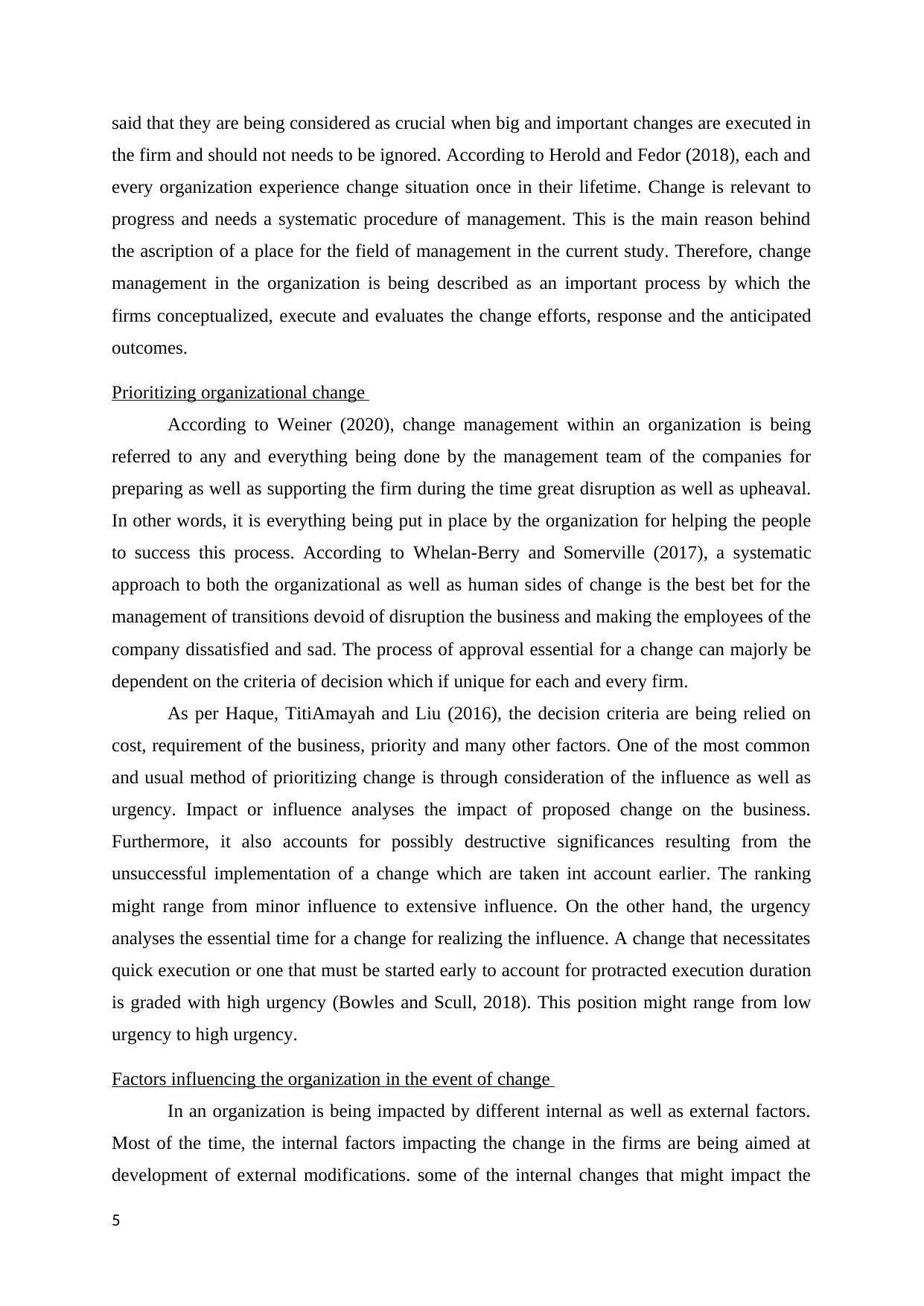
said that they are being considered as crucial when big and important changes are executed in
the firm and should not needs to be ignored. According to Herold and Fedor (2018), each and
every organization experience change situation once in their lifetime. Change is relevant to
progress and needs a systematic procedure of management. This is the main reason behind
the ascription of a place for the field of management in the current study. Therefore, change
management in the organization is being described as an important process by which the
firms conceptualized, execute and evaluates the change efforts, response and the anticipated
outcomes.
Prioritizing organizational change
According to Weiner (2020), change management within an organization is being
referred to any and everything being done by the management team of the companies for
preparing as well as supporting the firm during the time great disruption as well as upheaval.
In other words, it is everything being put in place by the organization for helping the people
to success this process. According to Whelan-Berry and Somerville (2017), a systematic
approach to both the organizational as well as human sides of change is the best bet for the
management of transitions devoid of disruption the business and making the employees of the
company dissatisfied and sad. The process of approval essential for a change can majorly be
dependent on the criteria of decision which if unique for each and every firm.
As per Haque, TitiAmayah and Liu (2016), the decision criteria are being relied on
cost, requirement of the business, priority and many other factors. One of the most common
and usual method of prioritizing change is through consideration of the influence as well as
urgency. Impact or influence analyses the impact of proposed change on the business.
Furthermore, it also accounts for possibly destructive significances resulting from the
unsuccessful implementation of a change which are taken int account earlier. The ranking
might range from minor influence to extensive influence. On the other hand, the urgency
analyses the essential time for a change for realizing the influence. A change that necessitates
quick execution or one that must be started early to account for protracted execution duration
is graded with high urgency (Bowles and Scull, 2018). This position might range from low
urgency to high urgency.
Factors influencing the organization in the event of change
In an organization is being impacted by different internal as well as external factors.
Most of the time, the internal factors impacting the change in the firms are being aimed at
development of external modifications. some of the internal changes that might impact the
5
the firm and should not needs to be ignored. According to Herold and Fedor (2018), each and
every organization experience change situation once in their lifetime. Change is relevant to
progress and needs a systematic procedure of management. This is the main reason behind
the ascription of a place for the field of management in the current study. Therefore, change
management in the organization is being described as an important process by which the
firms conceptualized, execute and evaluates the change efforts, response and the anticipated
outcomes.
Prioritizing organizational change
According to Weiner (2020), change management within an organization is being
referred to any and everything being done by the management team of the companies for
preparing as well as supporting the firm during the time great disruption as well as upheaval.
In other words, it is everything being put in place by the organization for helping the people
to success this process. According to Whelan-Berry and Somerville (2017), a systematic
approach to both the organizational as well as human sides of change is the best bet for the
management of transitions devoid of disruption the business and making the employees of the
company dissatisfied and sad. The process of approval essential for a change can majorly be
dependent on the criteria of decision which if unique for each and every firm.
As per Haque, TitiAmayah and Liu (2016), the decision criteria are being relied on
cost, requirement of the business, priority and many other factors. One of the most common
and usual method of prioritizing change is through consideration of the influence as well as
urgency. Impact or influence analyses the impact of proposed change on the business.
Furthermore, it also accounts for possibly destructive significances resulting from the
unsuccessful implementation of a change which are taken int account earlier. The ranking
might range from minor influence to extensive influence. On the other hand, the urgency
analyses the essential time for a change for realizing the influence. A change that necessitates
quick execution or one that must be started early to account for protracted execution duration
is graded with high urgency (Bowles and Scull, 2018). This position might range from low
urgency to high urgency.
Factors influencing the organization in the event of change
In an organization is being impacted by different internal as well as external factors.
Most of the time, the internal factors impacting the change in the firms are being aimed at
development of external modifications. some of the internal changes that might impact the
5
⊘ This is a preview!⊘
Do you want full access?
Subscribe today to unlock all pages.

Trusted by 1+ million students worldwide
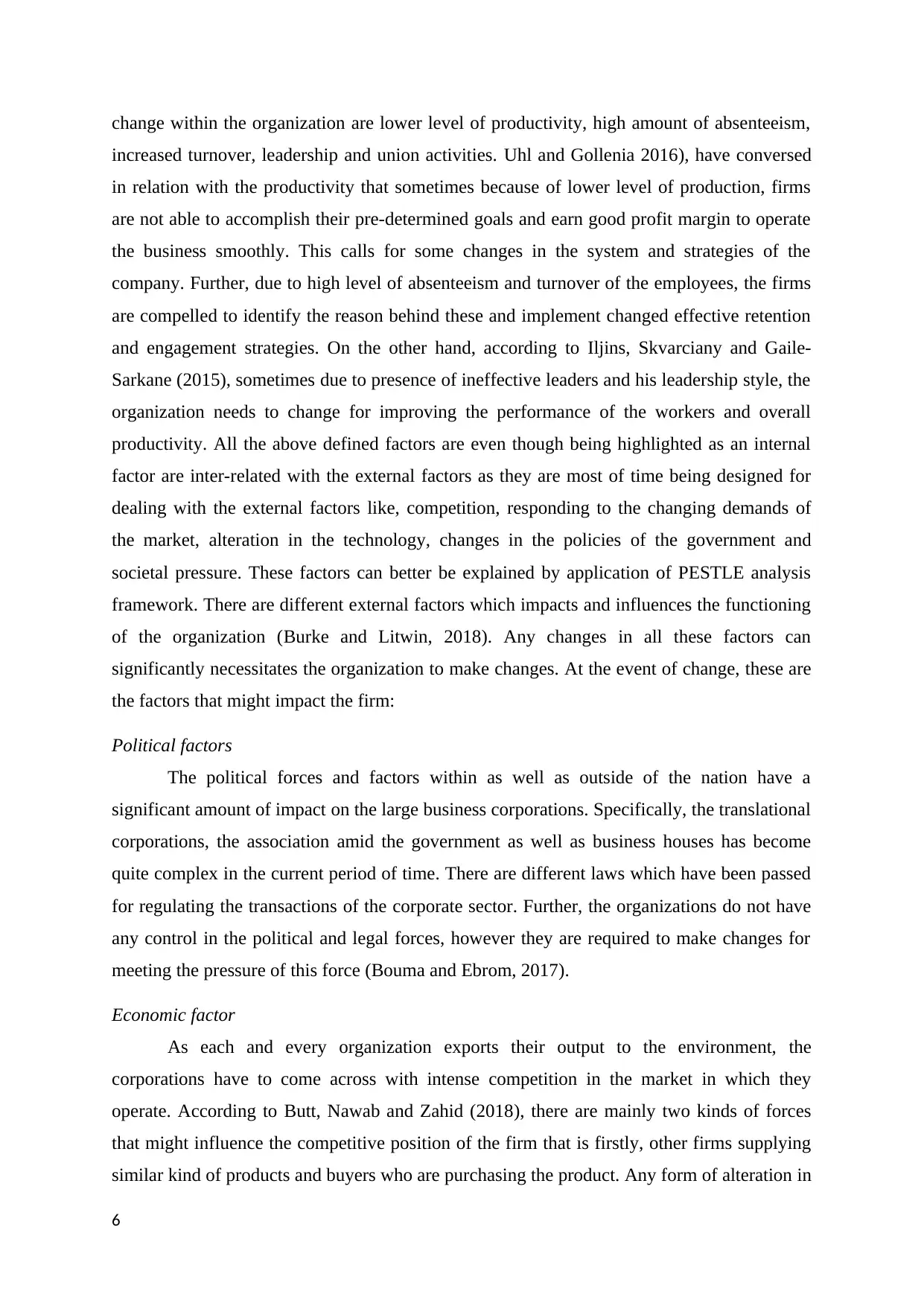
change within the organization are lower level of productivity, high amount of absenteeism,
increased turnover, leadership and union activities. Uhl and Gollenia 2016), have conversed
in relation with the productivity that sometimes because of lower level of production, firms
are not able to accomplish their pre-determined goals and earn good profit margin to operate
the business smoothly. This calls for some changes in the system and strategies of the
company. Further, due to high level of absenteeism and turnover of the employees, the firms
are compelled to identify the reason behind these and implement changed effective retention
and engagement strategies. On the other hand, according to Iljins, Skvarciany and Gaile-
Sarkane (2015), sometimes due to presence of ineffective leaders and his leadership style, the
organization needs to change for improving the performance of the workers and overall
productivity. All the above defined factors are even though being highlighted as an internal
factor are inter-related with the external factors as they are most of time being designed for
dealing with the external factors like, competition, responding to the changing demands of
the market, alteration in the technology, changes in the policies of the government and
societal pressure. These factors can better be explained by application of PESTLE analysis
framework. There are different external factors which impacts and influences the functioning
of the organization (Burke and Litwin, 2018). Any changes in all these factors can
significantly necessitates the organization to make changes. At the event of change, these are
the factors that might impact the firm:
Political factors
The political forces and factors within as well as outside of the nation have a
significant amount of impact on the large business corporations. Specifically, the translational
corporations, the association amid the government as well as business houses has become
quite complex in the current period of time. There are different laws which have been passed
for regulating the transactions of the corporate sector. Further, the organizations do not have
any control in the political and legal forces, however they are required to make changes for
meeting the pressure of this force (Bouma and Ebrom, 2017).
Economic factor
As each and every organization exports their output to the environment, the
corporations have to come across with intense competition in the market in which they
operate. According to Butt, Nawab and Zahid (2018), there are mainly two kinds of forces
that might influence the competitive position of the firm that is firstly, other firms supplying
similar kind of products and buyers who are purchasing the product. Any form of alteration in
6
increased turnover, leadership and union activities. Uhl and Gollenia 2016), have conversed
in relation with the productivity that sometimes because of lower level of production, firms
are not able to accomplish their pre-determined goals and earn good profit margin to operate
the business smoothly. This calls for some changes in the system and strategies of the
company. Further, due to high level of absenteeism and turnover of the employees, the firms
are compelled to identify the reason behind these and implement changed effective retention
and engagement strategies. On the other hand, according to Iljins, Skvarciany and Gaile-
Sarkane (2015), sometimes due to presence of ineffective leaders and his leadership style, the
organization needs to change for improving the performance of the workers and overall
productivity. All the above defined factors are even though being highlighted as an internal
factor are inter-related with the external factors as they are most of time being designed for
dealing with the external factors like, competition, responding to the changing demands of
the market, alteration in the technology, changes in the policies of the government and
societal pressure. These factors can better be explained by application of PESTLE analysis
framework. There are different external factors which impacts and influences the functioning
of the organization (Burke and Litwin, 2018). Any changes in all these factors can
significantly necessitates the organization to make changes. At the event of change, these are
the factors that might impact the firm:
Political factors
The political forces and factors within as well as outside of the nation have a
significant amount of impact on the large business corporations. Specifically, the translational
corporations, the association amid the government as well as business houses has become
quite complex in the current period of time. There are different laws which have been passed
for regulating the transactions of the corporate sector. Further, the organizations do not have
any control in the political and legal forces, however they are required to make changes for
meeting the pressure of this force (Bouma and Ebrom, 2017).
Economic factor
As each and every organization exports their output to the environment, the
corporations have to come across with intense competition in the market in which they
operate. According to Butt, Nawab and Zahid (2018), there are mainly two kinds of forces
that might influence the competitive position of the firm that is firstly, other firms supplying
similar kind of products and buyers who are purchasing the product. Any form of alteration in
6
Paraphrase This Document
Need a fresh take? Get an instant paraphrase of this document with our AI Paraphraser
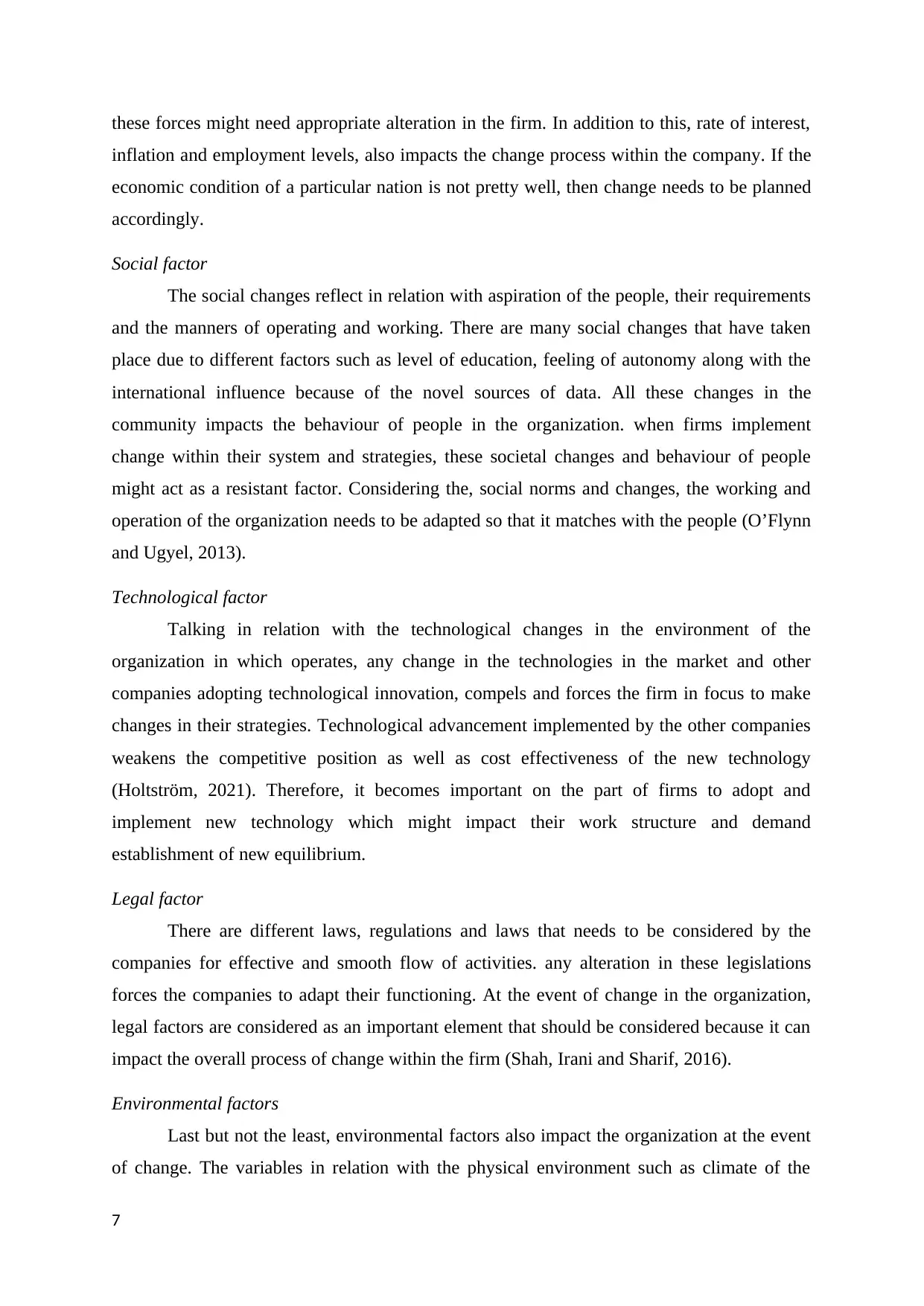
these forces might need appropriate alteration in the firm. In addition to this, rate of interest,
inflation and employment levels, also impacts the change process within the company. If the
economic condition of a particular nation is not pretty well, then change needs to be planned
accordingly.
Social factor
The social changes reflect in relation with aspiration of the people, their requirements
and the manners of operating and working. There are many social changes that have taken
place due to different factors such as level of education, feeling of autonomy along with the
international influence because of the novel sources of data. All these changes in the
community impacts the behaviour of people in the organization. when firms implement
change within their system and strategies, these societal changes and behaviour of people
might act as a resistant factor. Considering the, social norms and changes, the working and
operation of the organization needs to be adapted so that it matches with the people (O’Flynn
and Ugyel, 2013).
Technological factor
Talking in relation with the technological changes in the environment of the
organization in which operates, any change in the technologies in the market and other
companies adopting technological innovation, compels and forces the firm in focus to make
changes in their strategies. Technological advancement implemented by the other companies
weakens the competitive position as well as cost effectiveness of the new technology
(Holtström, 2021). Therefore, it becomes important on the part of firms to adopt and
implement new technology which might impact their work structure and demand
establishment of new equilibrium.
Legal factor
There are different laws, regulations and laws that needs to be considered by the
companies for effective and smooth flow of activities. any alteration in these legislations
forces the companies to adapt their functioning. At the event of change in the organization,
legal factors are considered as an important element that should be considered because it can
impact the overall process of change within the firm (Shah, Irani and Sharif, 2016).
Environmental factors
Last but not the least, environmental factors also impact the organization at the event
of change. The variables in relation with the physical environment such as climate of the
7
inflation and employment levels, also impacts the change process within the company. If the
economic condition of a particular nation is not pretty well, then change needs to be planned
accordingly.
Social factor
The social changes reflect in relation with aspiration of the people, their requirements
and the manners of operating and working. There are many social changes that have taken
place due to different factors such as level of education, feeling of autonomy along with the
international influence because of the novel sources of data. All these changes in the
community impacts the behaviour of people in the organization. when firms implement
change within their system and strategies, these societal changes and behaviour of people
might act as a resistant factor. Considering the, social norms and changes, the working and
operation of the organization needs to be adapted so that it matches with the people (O’Flynn
and Ugyel, 2013).
Technological factor
Talking in relation with the technological changes in the environment of the
organization in which operates, any change in the technologies in the market and other
companies adopting technological innovation, compels and forces the firm in focus to make
changes in their strategies. Technological advancement implemented by the other companies
weakens the competitive position as well as cost effectiveness of the new technology
(Holtström, 2021). Therefore, it becomes important on the part of firms to adopt and
implement new technology which might impact their work structure and demand
establishment of new equilibrium.
Legal factor
There are different laws, regulations and laws that needs to be considered by the
companies for effective and smooth flow of activities. any alteration in these legislations
forces the companies to adapt their functioning. At the event of change in the organization,
legal factors are considered as an important element that should be considered because it can
impact the overall process of change within the firm (Shah, Irani and Sharif, 2016).
Environmental factors
Last but not the least, environmental factors also impact the organization at the event
of change. The variables in relation with the physical environment such as climate of the
7
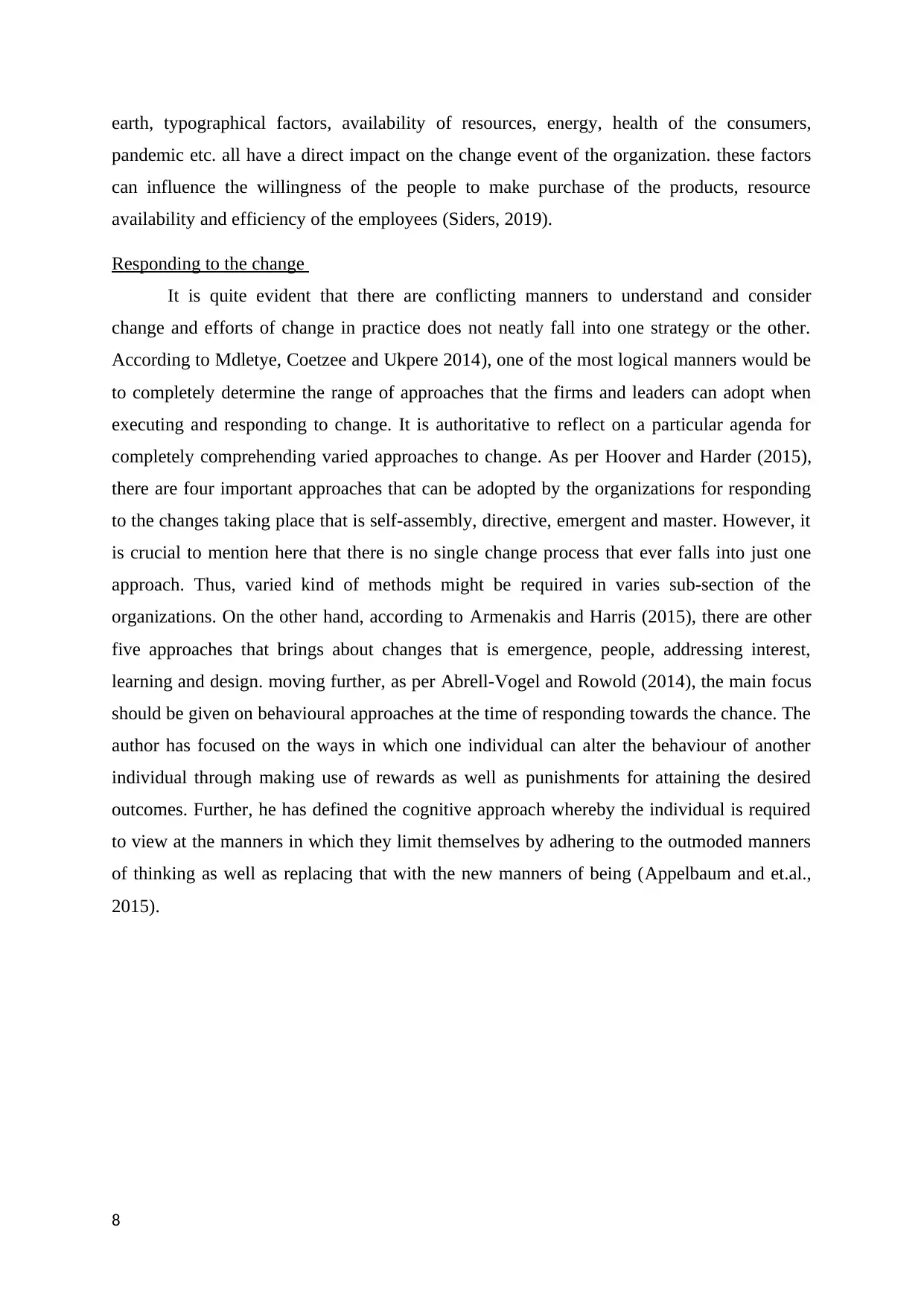
earth, typographical factors, availability of resources, energy, health of the consumers,
pandemic etc. all have a direct impact on the change event of the organization. these factors
can influence the willingness of the people to make purchase of the products, resource
availability and efficiency of the employees (Siders, 2019).
Responding to the change
It is quite evident that there are conflicting manners to understand and consider
change and efforts of change in practice does not neatly fall into one strategy or the other.
According to Mdletye, Coetzee and Ukpere 2014), one of the most logical manners would be
to completely determine the range of approaches that the firms and leaders can adopt when
executing and responding to change. It is authoritative to reflect on a particular agenda for
completely comprehending varied approaches to change. As per Hoover and Harder (2015),
there are four important approaches that can be adopted by the organizations for responding
to the changes taking place that is self-assembly, directive, emergent and master. However, it
is crucial to mention here that there is no single change process that ever falls into just one
approach. Thus, varied kind of methods might be required in varies sub-section of the
organizations. On the other hand, according to Armenakis and Harris (2015), there are other
five approaches that brings about changes that is emergence, people, addressing interest,
learning and design. moving further, as per Abrell-Vogel and Rowold (2014), the main focus
should be given on behavioural approaches at the time of responding towards the chance. The
author has focused on the ways in which one individual can alter the behaviour of another
individual through making use of rewards as well as punishments for attaining the desired
outcomes. Further, he has defined the cognitive approach whereby the individual is required
to view at the manners in which they limit themselves by adhering to the outmoded manners
of thinking as well as replacing that with the new manners of being (Appelbaum and et.al.,
2015).
8
pandemic etc. all have a direct impact on the change event of the organization. these factors
can influence the willingness of the people to make purchase of the products, resource
availability and efficiency of the employees (Siders, 2019).
Responding to the change
It is quite evident that there are conflicting manners to understand and consider
change and efforts of change in practice does not neatly fall into one strategy or the other.
According to Mdletye, Coetzee and Ukpere 2014), one of the most logical manners would be
to completely determine the range of approaches that the firms and leaders can adopt when
executing and responding to change. It is authoritative to reflect on a particular agenda for
completely comprehending varied approaches to change. As per Hoover and Harder (2015),
there are four important approaches that can be adopted by the organizations for responding
to the changes taking place that is self-assembly, directive, emergent and master. However, it
is crucial to mention here that there is no single change process that ever falls into just one
approach. Thus, varied kind of methods might be required in varies sub-section of the
organizations. On the other hand, according to Armenakis and Harris (2015), there are other
five approaches that brings about changes that is emergence, people, addressing interest,
learning and design. moving further, as per Abrell-Vogel and Rowold (2014), the main focus
should be given on behavioural approaches at the time of responding towards the chance. The
author has focused on the ways in which one individual can alter the behaviour of another
individual through making use of rewards as well as punishments for attaining the desired
outcomes. Further, he has defined the cognitive approach whereby the individual is required
to view at the manners in which they limit themselves by adhering to the outmoded manners
of thinking as well as replacing that with the new manners of being (Appelbaum and et.al.,
2015).
8
⊘ This is a preview!⊘
Do you want full access?
Subscribe today to unlock all pages.

Trusted by 1+ million students worldwide
1 out of 31
Related Documents
Your All-in-One AI-Powered Toolkit for Academic Success.
+13062052269
info@desklib.com
Available 24*7 on WhatsApp / Email
![[object Object]](/_next/static/media/star-bottom.7253800d.svg)
Unlock your academic potential
Copyright © 2020–2025 A2Z Services. All Rights Reserved. Developed and managed by ZUCOL.





